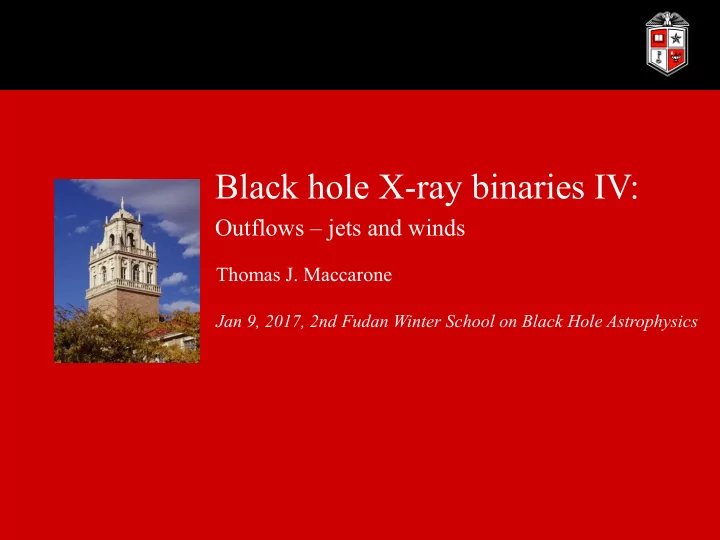

Black hole X-ray binaries IV: Outflows – jets and winds Thomas J. Maccarone Jan 9, 2017, 2nd Fudan Winter School on Black Hole Astrophysics
Overview Early discovery of jets in AGN Discoveries in X-ray binaries The “microquasar” paradigm Disk winds in different classes of systems
Fanaroff-Riley galaxies
Emission from jets Acciari et al. 2009; originally proposed in Konigl 1981
Energetics in AGN lobes and jets Baade (1956) – optical polarization seen in M87 jet Burbidge (1956) – energetics (~10^57 erg), showed there should also be gamma-rays Very exotic energy production mechanisms were considered Lynden-Bell (1969): “Galactic nuclei as collapsed old quasars”
Production of jets Not well understood Basic ideas are extraction of BH spin energy (Blandford & Znajek 1977) and extraction of accretion disk rotational energy (Blandford & Payne 1982)
K Jets from non-black holes Spin may be important for Radio from CVs: Koerding et al. 2008; determining power, but it is not image from Coppejans et al. 2015 essential for making jets!!
Radio must be from jets in most cases Start with flux measured Find radius if at 10^12 K Compare with size of orbit Emission must come from outside the binary orbit Called a “brightness temperature” argument
The microquasar paradigm Mirabel & Rodriguez 1994
Cygnus X-1again, along with GX 339-4 Fender et al. 1999 Tananbaum et al. 1972
From Hannikainen et al. 1997
General trends for black hole radio/X-ray relation L_R scales as L_X^0.7 power Significant scatter at high luminosities Corbel et al. 2003; Gallo et al. 2003 Figure from Coriat et al. 2010
Ballistic ejections at state transitions Jet speed fast when spectrum softer Fast jet overtakes slow jet in transition to soft state This leads to a dense work surface In hard state jet shock itself frequently Vadawale et al. 2003; Figure from Fender Gallo & Belloni 2005
AGN analogies I: a fundamental plane of AGN activity Merloni, Heinz & Di Matteo 2003
AGN II: Soft states in AGN Maccarone, Gallo & Fender 2003
Cygnus X-1's bubble Jet blows a bubble in interstellar medium Shock where this bubble ends Can use size scale and age of system to estimate the jet's kinetic power Jet appears to take away ~1/2 of accretion energy Gallo et al. 2005; Sell et al. 2015
Jet variability X-rays from inflow, IR from outflow. From Casella et al. 2010
Neutron star jets Migliari et al. 2006; Migliari et al. 2010
Ohsuga et al. 2009
X-rays from Jets I
X-rays from Jets II: constraints Many problems with jet X-ray model (but less serious for faint hard states): 1) Nearly constant hard X-ray cutoff 2) Cannot explain neutron stars looking similar in X-rays, but very different in radio 3) Cannot explain lack of Fermi emission from typical X-ray binaries 4) Jets are low radiative efficiency, so making the hard X-rays come from a jet means there should be jumps in X-ray luminosity at state transitions Jet models can match the broadband spectra, but have similar numbers of free parameters to the number of features in the spectra. Poutanen & Zdziarski 2004; Maccarone 2005
Accretion disk corona sources: first evidence for winds from XRBs Early in X-ray astronomy, a class seen: Dips/eclipses Little or no other variability Fainter than most other persistent X-ray binaries Prototype is 4U 1822-371 (Mason et al. 1980) Suggestion: only see scattered X-rays Light travel times smear out variability Originally was thought that the “corona” in which hard X-rays produced scatters the light, but also was suggested that there were disk winds even back in the 1980s (Begelman, McKee & Shields 1983)
Absorption in GRS 1915+105 Strong absorption in soft states Rapidly turns off in hard states Suggests that the disk winds are powerful only in the soft states (Neilsen & Lee 2009) This has some similarities with the AGN optical emission line morphology – when radio loud, double peaked lines are seen, but not when radio quiet (Eracleous & Halpern 1993)
A general trend in absorption
Conclusions Jets are seen in nature whenever there is a geometrically thick accretion disk Large scale height magnetic fields are probably needed to produce the jets The behavior of AGN and stellar mass black hole jets shows broad similarities The basic physics of accretion does not depend strongly on scale of the black hole
Recommend
More recommend